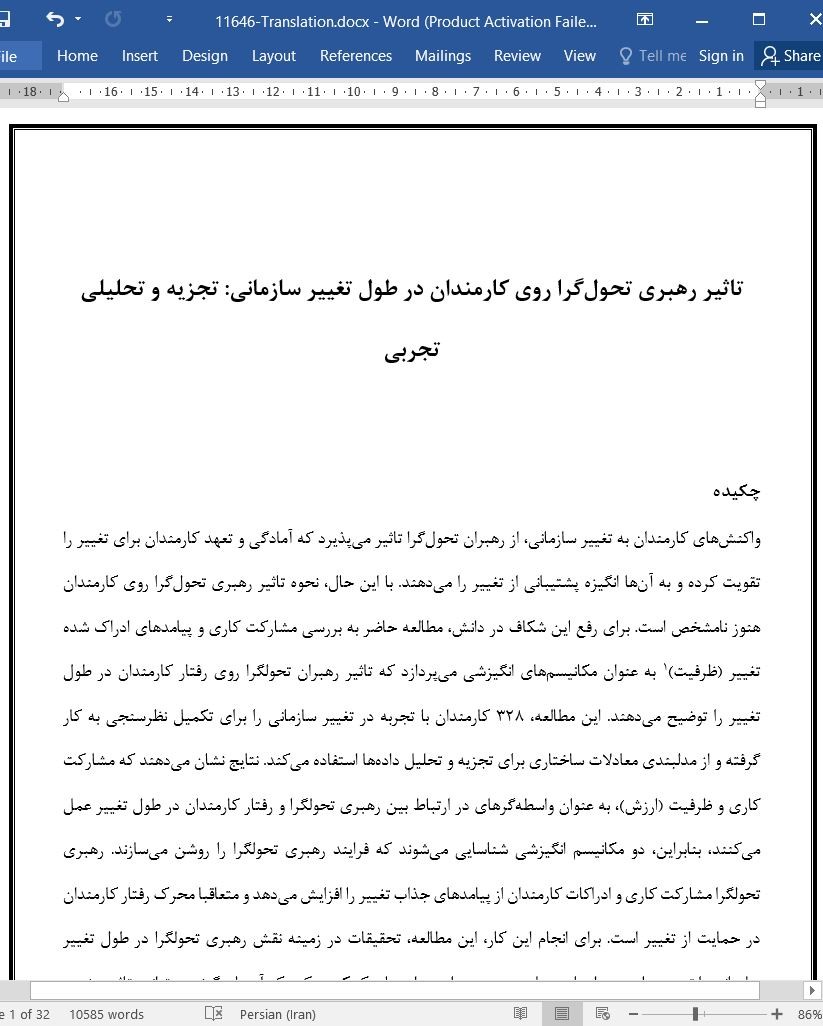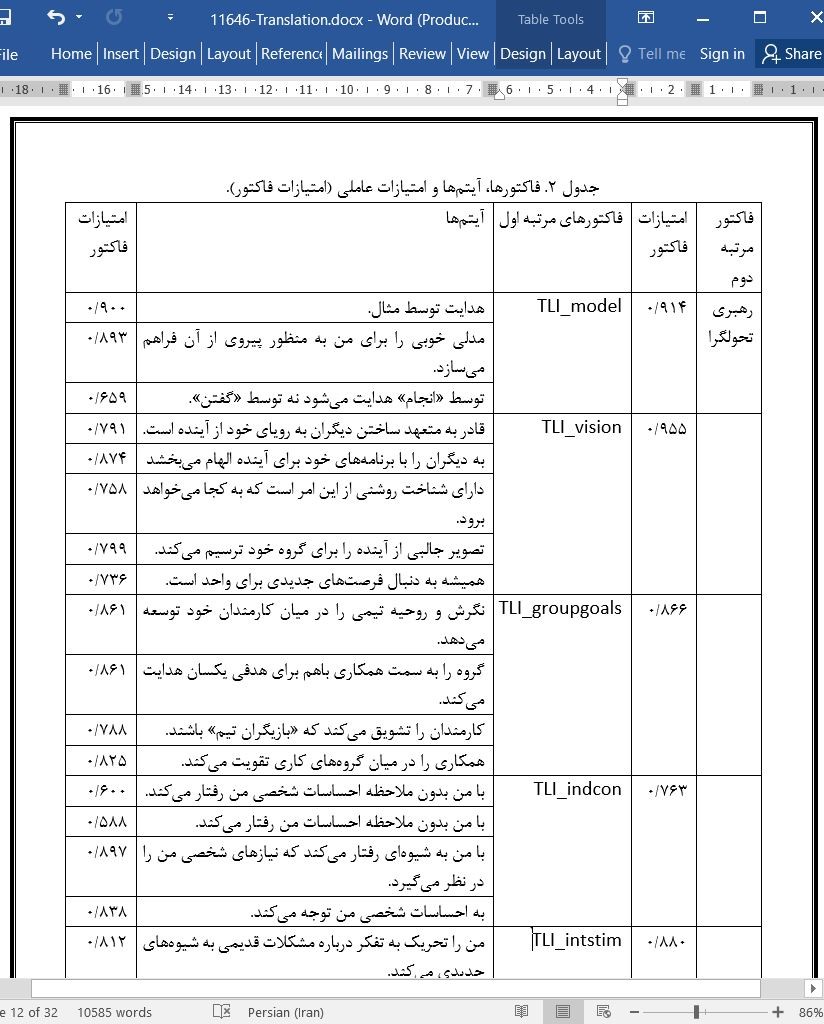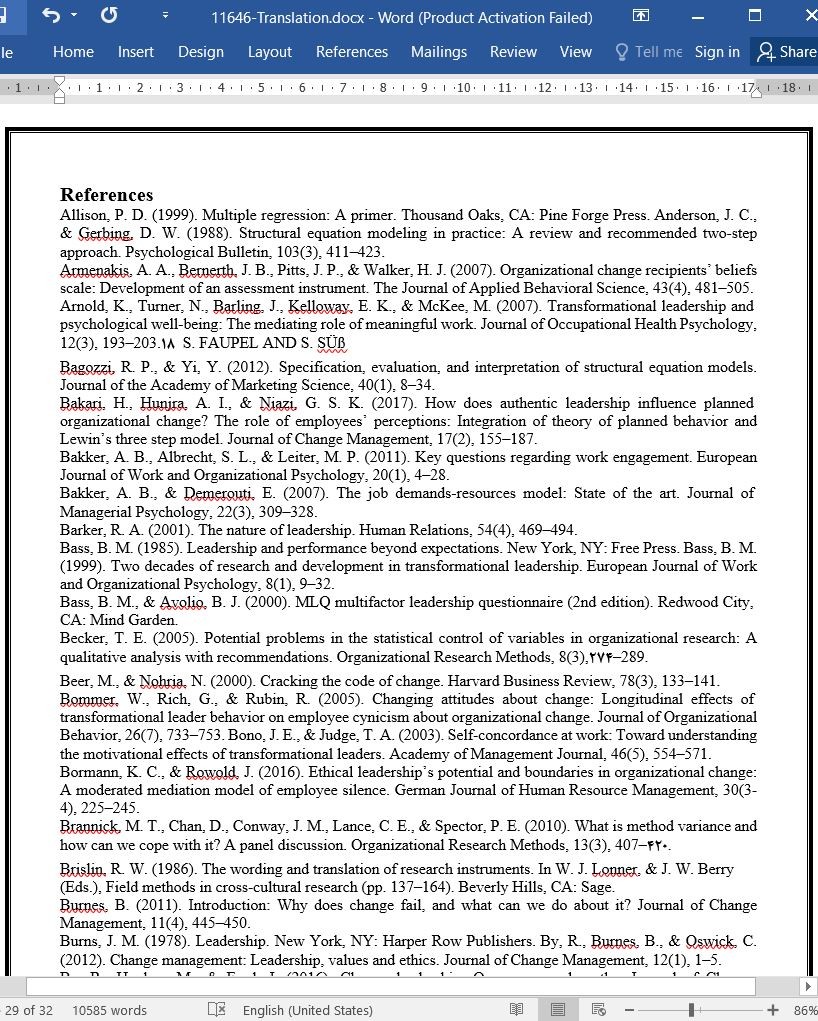
تاثیر رهبری تحولگرا روی کارمندان در طول تغییر سازمانی
چکیده
واکنشهای کارمندان به تغییر سازمانی، از رهبران تحولگرا تاثیر میپذیرد که آمادگی و تعهد کارمندان برای تغییر را تقویت کرده و به آنها انگیزه پشتیبانی از تغییر را میدهند. با این حال، نحوه تاثیر رهبری تحولگرا روی کارمندان هنوز نامشخص است. برای رفع این شکاف در دانش، مطالعه حاضر به بررسی مشارکت کاری و پیامدهای ادراک شده تغییر (ظرفیت) به عنوان مکانیسمهای انگیزشی میپردازد که تاثیر رهبران تحولگرا روی رفتار کارمندان در طول تغییر را توضیح میدهند. این مطالعه، 328 کارمندان با تجربه در تغییر سازمانی را برای تکمیل نظرسنجی به کار گرفته و از مدلبندی معادلات ساختاری برای تجزیه و تحلیل دادهها استفاده میکند. نتایج نشان میدهند که مشارکت کاری و ظرفیت (ارزش)، به عنوان واسطهگرهای در ارتباط بین رهبری تحولگرا و رفتار کارمندان در طول تغییر عمل میکنند، بنابراین، دو مکانیسم انگیزشی شناسایی میشوند که فرایند رهبری تحولگرا را روشن میسازند. رهبری تحولگرا مشارکت کاری و ادراکات کارمندان از پیامدهای جذاب تغییر را افزایش میدهد و متعاقبا محرک رفتار کارمندان در حمایت از تغییر است. برای انجام این کار، این مطالعه، تحقیقات در زمینه نقش رهبری تحولگرا در طول تغییر سازمانی را توسعه داده و به ایجاد حساسیت در مدیران در این باره کمک میکند که آنها چگونه میتوانند تاثیر مثبتی روی کارمندان در دوره تغییر سارمانی داشته باشند.
پیشگفتار
به دلیل تحولاتی از قبیل دیجیالیسازی، تغییرات جمعیت شناختی و جهانی شدن، سازمانها اگر به دنبال این هستند که همچنان رقابتی باقی بمانند باید به طور پیوسته تغییر کنند (داپلر، فهرمن، لبواسچک، و وویت، 2011). سازمانها، روندهایی از تغییرات را آغاز میکنند که شامل اتخاذ استراتژیهای جدید، تنظیم ساختارها و اجرای شکلهای جدید و انطعافپذیرتری از اشتغال هستند (داپلر و همکاران، 2011). از آنجایی که بسیاری از تغییرات سازمانی، در دستیابی به اهداف تعریف شده خود موفق نمیشوند (بیر و نوهریا، 2000؛ برنز، 2011)، تحقیقات تجربی در زمینه فاکتورهای تغییر موفقیت آمیز افزایش یافتهاند (هرسکویچ و میر، 2002؛ اورگ، واکولا، و آرمناکیس، 2011). در حالی که دلایل متعددی برای نرخهای پایین موفقی فرایندهای تغییر سازمانی وجود دارند، محققان کشف کردهاند که کارمندان، خود دارای تاثیر ژرفی هستند (بورمن و روولد، 2016؛ اورگ و همکاران، 2011؛ سلف، آرمناکیس و شرادر، 2007)، زیرا آنها هستند که تغییرات برنامهریزی شده را اجرا کرده و به تغییرات در روالهای کاری خود سازگار با تغییرات سازمانی پاسخ میدهند. اگر تغییرات برنامهریزی شده، در سطح فردی موفق نشوند، در سطح سازماین نیز نمیتوانند موفق شوند، بنابراین انگیزه و رفتار کارمندان به عنوان عوامل حیاتی در موفقیت تغییرات سازمانی شناخته شدهاند (کیم، هورنانگ و روسیو، 2010؛ ون دل هیوول، دمروتی، بیکر و شافلی، 2010؛ وودمن و دیوت، 2004).
ABSTRACT
Employees’ reactions to organizational change are affected by transformational leaders, who foster employees’ readiness for and commitment to change and motivate them to act in support of the change. However, just how transformational leadership affects employees remains unclear. To address this gap in knowledge, the present study analyses work engagement and the perceived consequences of a change (valence) as motivational mechanisms that explain the influence of transformational leaders on employees’ behaviour during change. The study engaged 328 employees who were experiencing organizational change to complete a survey and used structural equation modelling for data analysis. Results show that work engagement and valence function as mediators in the relationship between transformational leadership and employee behaviour during change, so two motivational mechanisms are identified that shed light on the leadership process. Transformational leadership increases employees’ work engagement and perceptions of attractive change consequences, subsequently evoking employee behaviour in support of change. In doing so, the study expands the research on the role of transformational leadership during organizational change and helps to sensitize managers about how they can positively influence employees in the course of organizational change.
Introduction
Because of developments such as digitization, globalization and demographic change, organizations must change continually if they are to stay competitive (Doppler, Fuhrmann, Lebbe-Waschke, & Voigt, 2011). Organizations initiate processes of change that include adopting new strategies, adjusting structures and implementing new or more flexible forms of employment (Doppler et al., 2011). Since many organizational changes fail to reach their defined objectives (Beer & Nohria, 2000; Burnes, 2011), empirical research on the factors of successful change has grown (Herscovitch & Meyer, 2002; Oreg, Vakola, & Armenakis, 2011). While there are multiple reasons for the low success rates of organizational change processes, researchers have found that employees themselves have a profound impact (e.g. Bormann & Rowold, 2016; Oreg et al., 2011; Self, Armenakis, & Schraeder, 2007), as it is them who put planned changes into action and respond to the variations in their work routines that come with organizational changes. If planned changes are not realized on the individual level, they cannot be successful on the organizational level, so employees’ motivation and behaviour have been found to be crucial to the success of organizational changes (Kim, Hornung, & Rousseau, 2010; Van den Heuvel, Demerouti, Bakker, & Schaufeli, 2010; Woodman & Dewett, 2004).
چکیده
پیشگفتار
پیش زمینه نظری و توسعه فرضیات
رهبری تحولگرا، ظرفیت و مشارکت کاری
واسطهگری پیوندهای بین رهبری تحولگرا و رفتار کارمندان
روش
نمونه
معیارها
رهبری تحولگرا
ظرفیت
مشارکت کاری
رفتار قهرمانانه
متغیرهای کنترل/متغیرهای مورد نظر
روالهای تجزیه و تحلیل دادهها
نتایج
تجزیه و تحلیلهای توصیفی
نتایج تجزیه و تحلیل عامل تاییدی
آزمایش فرضیات: مدل ساختاری
بحث
تفسیر نتایج
نقش (کمک) مطالعه
محدودیتها و پیامدهای برای تحقیقات آینده
نتیجهگیری
منابع
ABSTRACT
Introduction
Theoretical background and development of hypotheses
Transformational leadership, valence and work engagement
Mediating links between transformational leadership and employees’ behaviour
Method
Sample
Measures
Transformational leadership
Valence
Work engagement
Championing behaviour
Control variables/variables of interest
Procedures for data analysis
Results
Descriptive analyses
Confirmatory factor analysis results
Hypotheses testing: the structural model
Discussion
Interpretation of results
Contribution
Limitations and implications for future research
Conclusion
References
- اصل مقاله انگلیسی با فرمت ورد (word) با قابلیت ویرایش
- ترجمه فارسی مقاله با فرمت ورد (word) با قابلیت ویرایش، بدون آرم سایت ای ترجمه
- ترجمه فارسی مقاله با فرمت pdf، بدون آرم سایت ای ترجمه



